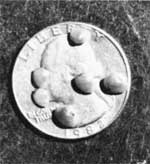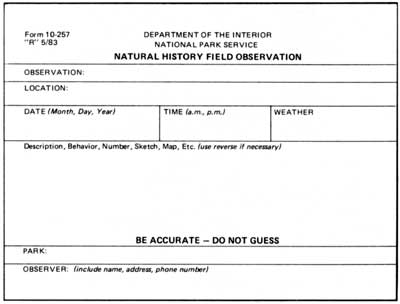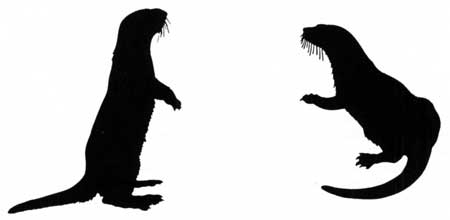Mustelids in Crater Lake?
The term mustelid comes from the zoological family name Mustelidae and is used to refer to the group of animals in that family. Included in this group are martens, fishers, weasels, ferrets, mink, wolverines, badgers, skunks, and otters. Representatives of this group are found all over the world and in almost every type of habitat.
Most members of the mustelid family are relatively small, with long, low-slung bodies, short legs, short rounded ears, and a thick silky coat. Primarily nocturnal (active at night), all mustelids are solitary and remain alert throughout the year. Mustelids are mainly carnivorous, eating small mammals, fish, birds, eggs, amphibians, and some plant matter such as berries. Most of the species in this family have paired anal scent glands, which in skunks are highly developed for defense. In most other mustelid species, the secretions are used more as social and sexual signals. Animals such as otters and wolverines spend a great deal of time marking their “space” by rubbing their scent glands on surfaces throughout their territory.
Mustelids exhibit a fair amount of play behavior. Otters, for example, are noted for their ”playful” behavior and spend time with other otters when engaged in “play.” Of course, we have to be careful about crediting animals with human attributes. Many of these perceived “games” animals play are actually excellent training exercises for survival because they strengthen muscles and sharpen reflexes. It is interesting to note that the primate family (which includes humans) is the only other group of mammals that consistently exhibits such behavior.
Recently there have been several sightings of mustelid-like animals in Crater Lake. At this point, however, we have no confirmed reports of mustelids using the lake but most of the human activity on Crater Lake is centered on a relatively small portion of the caldera. The surface of Crater Lake covers 21 square miles, so there is plenty of room for an animal to remain undetected. Since mustelids tend to be shy creatures and avoid human contact, the difficulty in confirming sightings is probably further compounded.
Crater Lake could be an attractive food source for mustelids. Introduced fish and shellfish, as well as native salamanders and invertebrates, are all possible mustelid foods. The lake is also well within the ranges (which can extend from five to fifteen square miles) of these animals.
What kindofmustelid may be using Crater Lake? River otters are a dim possibility since they are known to fish and swim. Otter sightings are rare in the park (none have been recorded in recent years), so the most likely mustelid is the pine marten. These animals are regularly sighted in the park and along the shores of Crater Lake, but are not known to fish or swim. Although smaller in size than otters or martens, the long-tailed weasel and short-tailed weasel swim and are strong possibilities.
An example of a wildlife observation form is shown below. The National Park Service needs well- documented observations of the park’s wildlife as a first step toward perpetuating their existence. Studies conducted outside of the park can provide better scientific understanding about mustelid species, but they cannot determine if these animals are using Crater Lake. Only with detailed observations (including length, color, shape or head, behavior, and location) can gaps in the park’s wildlife records be filled. Please ask for forms at Crater Lake National Park’s visitor information centers.
Mysterious Clams of Crater Lake National Park
High on a remote, dry ridge, 700 feet above the surrounding valleys, is a small pond. It is not very big, perhaps 40 feet in diameter. The shore is lined by thickets of huckleberry and shaded by tall pines. Silence seems to be its dominant attribute. If its surface was not occasionally rippled by the quick scamper of a water skipper or the lazy flip of a salamander’s tail, one would find it easy to assume that this quiet pond was completely uninhabited. Nevertheless, this small pool of water is actually home to hundreds of aquatic creatures, most of whom are hidden in the pond’s soft mud. It only takes a moment of sifting through this mud to reveal a horde of these kicking, squirming invertebrates. Of all the strange creatures you will find in this community, however, by far the most puzzling ones are white, pebble-sized, fresh water clams. They are not necessarily rare, since populations can be found in Upper Klamath Lake as well as in the Rogue and Umpqua river basins. But how have these clams come to exist in a pond located on a dry, remote ridge high above the surrounding river basins? Looking at the physical capabilities of these clams does not make this mystery any easier to solve.
 |
Mysterious Clams The adults get larger than a fourth of an inch in diameter |
Clam Presence an Anomaly
The clams found in the small remote ponds of Crater Lake National Park are small in size, in most cases less than a fourth of an inch in diameter. They are sedate creatures, and for the most part, spend their lives in the pond’s mud siphoning microscopic organisms out of the water. Despite their small size and sedate habits, they are known to crawl at a speed of about eight inches per hour. This means that if they were to crawl for 24 hours a day, it would take about three weeks for one of these clams to crawl the length of a football field and almost a year to crawl a mile. While highly unlikely, these clams could have crawled to this pond from the nearest stream. In the case of the small and isolated pond, the stream is located about a mile away. The problem with this scenario is that these clams have gills and must remain in the water as they move. Since this pond is filled with snow and rain that falls directly into its basin, there is not much runoff from it. What little it does leave flows over a rocky ledge and is promptly absorbed by the forest floor below. Without a distinct and permanent water course, the possibility that clams could have crawled to this isolated pond is small. For the clams of Crater Lake National Park, their presence in remote ponds might be better explained if their reproductive abilities are examined.
The reproductive cycle of clams in the Sphaeriidae family is surprisingly similar to what is seen in the marsupials. As the zygotes of the clam pass out of the sexual ducts, they are collected in a brooding zone of the gills called a marsupia. Here the young grow until they have developed into a miniature version of the adult. Mature clams are known to contain from one to twenty of these juveniles in various stages of development. It is this brood inside the adult clam that represents the key in the clam’s ability to travel extensive distances.
Distribution by Birds
Most investigators have attributed the presence of clams in remote or isolated ponds to transport by birds. This is because ducks and great blue herons, for example, relish these pill sized clams for food. When they are eaten by the bird, the adult clam usually perishes in the upper part of the bird’s digestive tract. The brood of young clams inside the adult, however, are protected from this acrid environment until the adult dies. Many of these young clams survive the lower digestive tract, too. If the bird that ate them should happen to fly to a different location that is suitable for these clams, then the survivors that pass out of the bird’s digestive tract will find themselves in a new home that is often far removed from their former one.
Distribution of clams by birds is the most common mode of transportation mentioned in references on these aquatic invertebrates. What is rarely mentioned, though, are the details on how these clams might be transported by mammals. This is important at Crater Lake National Park because animals of this perk probably have their own way of moving these clams from pond to pond in ways that have not been thoroughly investigated. A clue to this other type of transport can be found near the park’s west boundary, in a wet meadow called Sphagnum Bog.
Distribution by Mammals
Sphagnum Bog is a broad, wet, open field bordered on all sides by a wall of hemlock trees. Low stands of shrubs and grass grow in the mud of countless seeps and puddles. This area is a haven for clams, as evidenced by the shells from past generations found scattered throughout the area. High concentrations of these shells can be found in mud holes that form wide craters in several places around the bog. These mud holes are not just coincidental in nature, nor do they occur randomly. They represent locations where elk come at various times to wallow in the deep, soft mud of the bog.
Wallowing is most often observed in mid-August to late September while bull elk are in their rut. It is common to see these bulls covered with mud as they wander about in search of mates during this time. With the high density of clams observed in areas used for wallowing, it is conceivable that tens or hundreds of clams may be carried away from wallow areas in the mud on the backs of these bulls. Since these clams are known to live out of the water for three to four days, if temperatures are cool enough, it is probable that clams “hitch hiking” a ride in the mud on these elk could be distributed from wallow to wallow and from pond to pond. Since these clams are hermaphrodites, it would only take one clam to establish a new colony in ponds “seeded” by the elk. Because elk use the park as a summer home, migration route, and reproductive domain, it is also reasonable to conclude that these mammals are probably more important than birds in the distribution of clams at Crater Lake National Park.



